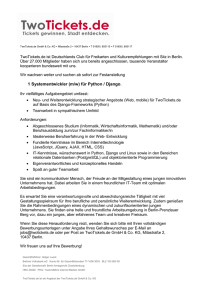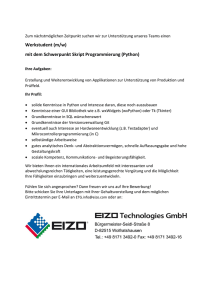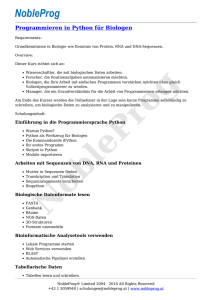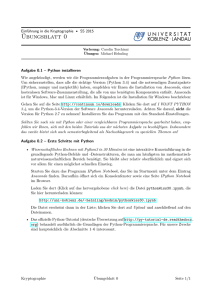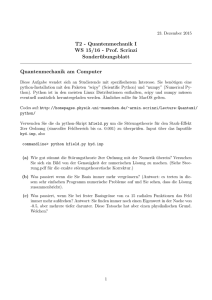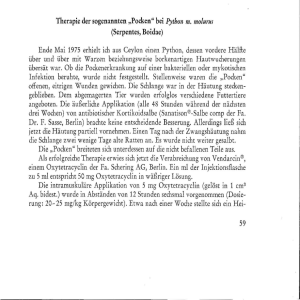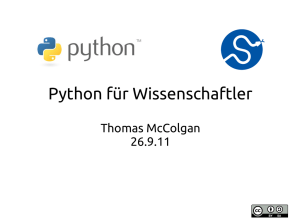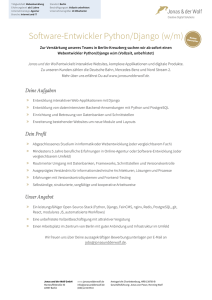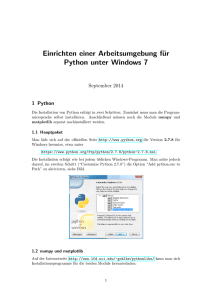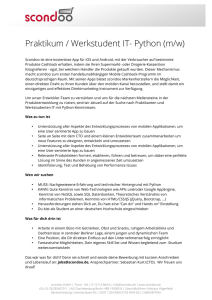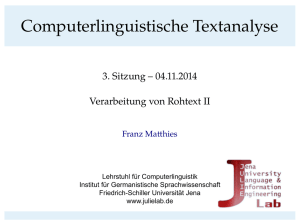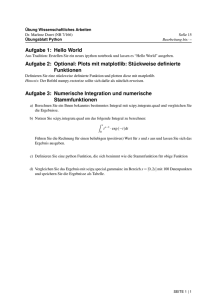Python für Wissenschaftler
Werbung
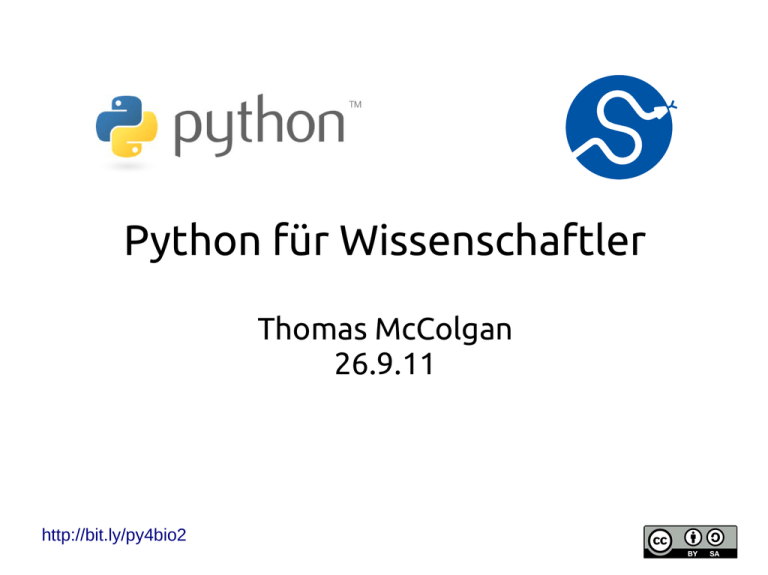
Python für Wissenschaftler
Thomas McColgan
26.9.11
http://bit.ly/py4bio2
1/35
Inhalt
●
Was ist Python?
●
Beispiel-Workflow
●
Getting started
2/35
Was ist Python
●
Python ist freie Software
●
Dynamische Skriptsprache
●
einfache und eindeutige Syntax
●
Umfangreiche Standardbibliothek
●
Viele Pakete für Wissenschaft
3/35
Was ist Python
●
Python ist freie Software
●
Dynamische Skriptsprache
●
einfache und eindeutige Syntax
●
Umfangreiche Standardbibliothek
●
Viele Pakete für Wissenschaft
4/35
Wieso frei?
●
Frei wie Freibier
●
Open-Source Community
●
●
Guido van Rossum: Benevolent Dictator For Life
●
Entwickler == Benutzer
●
Unterstützt von Google, Yahoo, CERN, NASA, …
Offene Standards
●
kein Lock-in
5/35
Was ist Python
●
Python ist freie Software
●
Dynamische Skriptsprache
●
einfache und eindeutige Syntax
●
Umfangreiche Standardbibliothek
●
Viele Pakete für Wissenschaft
6/35
Dynamische Skriptsprache
2 Modi:
●
Interaktiv
# python
>>> print "Hello biology!"
Hello biology!
●
Batch
# python hello.py
Hello biology!
7/35
Multi-paradigma
●
Prozedural
●
●
●
Befehle nacheinander eingeben
Funktional
●
Befehle in Funktionen bündeln
●
Closures: Funktionen an Funktionen übergeben.
Objektorietiert
●
Daten und Funktionen in sinnvolle Pakete bündeln
●
Alles ist ein Objekt
8/35
Modular
●
Funktionen werden hierarchisch sortiert
●
Laden nach Bedarf
●
Ursprung einer Funktion immer klar
●
Module können interagieren
9/35
Was ist Python
●
Python ist freie Software
●
Dynamische Skriptsprache
●
einfache und eindeutige Syntax
●
Umfangreiche Standardbibliothek
●
Viele Pakete für Wissenschaft
10/35
Syntax
●
Whitepace matters
Python:
x = 0
for i in range(10):
print i
if x != 3:
x += i**2
print x
Matlab:
x = 0;
for i = 0:9
i
if x ~= 3
x += i^2;
end
x
end
11/35
Was ist Python
●
Python ist freie Software
●
Dynamische Skriptsprache
●
einfache und eindeutige Syntax
●
Umfangreiche Standardbibliothek
●
Viele Pakete für Wissenschaft
12/35
Standardbibliothek
●
„Batteries included“
●
Funktionen bei Bedarf importieren
●
Über 100 Pakete, z.B.:
●
●
datetime
●
csv
●
webbrowser
●
audioop
http://docs.python.org/library/
13/35
Was ist Python
●
Python ist freie Software
●
Dynamische Skriptsprache
●
einfache und eindeutige Syntax
●
Umfangreiche Standardbibliothek
●
Viele Pakete für Wissenschaft
14/35
Scientific stack
iPython
SciKits
Brian
viele mehr
...
SciPy
NumPy
Standardbibliothek
Python
15/35
Wissenschaftlicher Workflow
Dokumentation
und Tests
Präsentation
Auswertung
Datenaufnahme
Simulation
16/35
Wissenschaftlicher Workflow
Dokumentation
und Tests
Präsentation
Auswertung
Datenaufnahme
Simulation
17/35
Dokumentation
●
Dokumentation:
●
Docstrings:
def meinefunktion(x):
“ “ “ Wert um 1 erhöhen“ “ “
return x + 1
●
●
pydoc (Standardbibliothek)
●
Sphinx (http://sphinx.pocoo.org/)
Code-Stil und Hinweise:
●
●
Community-Konventionen: PEP-8 (link)
pylint: Detailierte analyse des Codes, mit
Gesamtpunktzahl
18/35
Tests
●
●
Testing
●
doctest (Standardbibliothek)
●
nosetests (http://readthedocs.org/docs/nose/en/)
Profiling
●
timeit: Schnelle Tests für Laufzeiten
●
profile, hotshot: Detaillierteres profiling
●
Alle 3 in der Standardbibliothek
19/35
Wissenschaftlicher Workflow
Dokumentation
und Tests
Präsentation
Auswertung
Datenaufnahme
Simulation
20/35
Datenaufnahme
●
csv, xml, file (Standardbibliothek)
●
Neo (http://packages.python.org/neo/):
●
Interface für viele E-Phys Datenformate: Plexon, Spike2,
NeuroExplorer, pCLAMP and AxoScope, Tucker Davis Ttank, Micromed,
Neuroshare, EEGLAB, WinWCP, WinEdr, HDF5,...
●
Erweiterbar für neue Formate
●
Einfaches Einlesen zur Verwendung in Python:
>>> from neo.io import MyFormatIO
>>> file = MyFormatIO("myfile.dat")
>>> file.supported_objects
[Segment , AnalogSignal , SpikeTrain, Event, Spike ]
>>> seg = file.read_segment()
>>> seg.get_analogsignals()
21/35
Wissenschaftlicher Workflow
Dokumentation
und Tests
Präsentation
Auswertung
Datenaufnahme
Simulation
22/35
Simulation
●
Brian Hears
http://www.briansimulator.org/docs/hears.html
from brian import *
from brian.hears import *
sound1 = tone(1*kHz, .1*second)
sound2 = whitenoise(.1*second)
sound = sound1+sound2
sound = sound.ramp()
sound.play()
cf = erbspace(20*Hz, 20*kHz, 3000)
fb = Gammatone(sound, cf)
output = fb.process()
23/35
Wissenschaftlicher Workflow
Dokumentation
und Tests
Präsentation
Auswertung
Datenaufnahme
Simulation
24/35
Analyse
●
Scipy (http://www.scipy.org/)
●
viele Funktionen aus lin. Algebra, Statistik, etc...
>>> D = np.diag((-1,1))
>>> scipy.linalg.eigvals(D)
array([-1., 1.])
●
Ipython (http://ipython.org/)
●
verbesserte interaktive Shell
●
ideal für explorative Analyse
●
Skalieren von Einzelrechner bis zum Cluster
25/35
Wissenschaftlicher Workflow
Dokumentation
und Tests
Präsentation
Auswertung
Datenaufnahme
Simulation
26/35
Präsentation
●
Matplotlib (http://matplotlib.sourceforge.net/)
●
Matlab-style Interface
●
„Publikationsqualität“
27/35
Präsentation (2)
●
Mayavi2
(http://code.enthought.com/projects/mayavi/)
●
Hochwertige 3D-Visualisierungen
●
Interaktives Interface
28/35
Getting started
29/35
Python installieren
●
Linux:
●
●
●
trivial
Mac OS:
●
Python vorinstalliert (alte Version)
●
Installer von Webseite
●
fink, macports, homebrew, …
Windows (seufz):
●
Installer von Webseite
●
Besser: EPD (http://www.enthought.com/)
30/35
Pakete installieren
●
●
●
Verzeichnis (fast) aller Pakete: PyPI
http://pypi.python.org/
Installer: easy_install (alt) und pip
http://www.pip-installer.org/
Alternativ: Paket herunterladen und selber
installieren
# cd meinpaket
# python setup.py install
31/35
Further reading
●
●
●
Dive into Python (http://diveintopython.org/)
Getting Started (offizielles Tutorial)
http://www.python.org/about/gettingstarted/
Neural Ensemble (http://neuralensemble.org/)
32/35
Python vs. Matlab
●
●
●
Matlab:
●
Weit verbreitet
●
Gute IDE
●
speziell für Wissenschaftler/Ingenieure entwickelt
Python:
●
Open Source
●
Moderne Sprache
●
kann viele Funktionen von Matlab imitieren
●
schnell wachsende Community
Detailierter Vergleich:
http://www.scipy.org/NumPy_for_Matlab_Users
33/35
One last thing...
●
Viele dieser Tools werden von
Wissenschaftlern entwickelt
●
Wer sie verwendet, sollte sie zitieren.
●
Zum Beispiel:
@Misc{,
author =
{Eric Jones and Travis Oliphant and Pearu Peterson and others},
title =
{{SciPy}: Open source scientific tools for {Python}},
year =
{2001--},
url = "http://www.scipy.org/"
}
34/35
Vielen Dank
http://bit.ly/py4bio2
35/35
